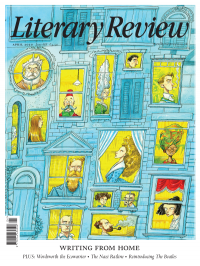Miranda France
Love in the Time of Plague
Hamnet
By Maggie O'Farrell
Tinder Press 368pp £20
It’s 1596 and London is in the grip of plague. ‘The playhouses are all shut, by order of the Queen, and no one is allowed to gather in public.’ The inhabitants are ‘hereby ordered not to go out, not to take to the streets, but to remain indoors until the pestilence is past’.
These circumstances – which are no longer as hard to imagine as they were last month – provide the setting for Maggie O’Farrell’s reconstruction of William Shakespeare’s courtship of and marriage to Anne Hathaway. He was eighteen when they married; she was twenty-six and pregnant with their first child, Susanna. Twins Judith and Hamnet followed, and at the heart of this story is Hamnet’s death from the plague at the age of eleven.
What’s in a name? Quite a lot in this novel. Anne goes by Agnes here, the name she was given in her father’s will. Hamnet and Hamlet were at that time interchangeable names, making the playwright’s decision to name a play after his son, some four years after the boy’s death, both puzzling and poignant. Shakespeare himself is not named at all, but is a marginal character, clever if fey, his day job a mystery to his family. Agnes realises that he likes writing but isn’t sure what he writes about and finds his long absences a nuisance. Susanna secretly hopes the plague will worsen in London and bring him home. His later success baffles the neighbours: ‘Everyone thought the glover’s son would amount to nothing, what a wastrel he had always seemed, and now look at him – a man of consequence in London, it is said, and there he goes, with his richly embroidered sleeves and shining leather boots.’
The novel’s protagonist, then, is Agnes. O’Farrell imagines her as a headstrong young woman who keeps a trained hawk and has certain mystical powers. Some people think she may be a witch. She meets Shakespeare when he comes to her parents’ farm to tutor her brothers. The young playwright-to-be is helping to pay off debts incurred by his father, John, a disreputable animal skins merchant. There’s a memorable sex scene in the apple store and the resultant pregnancy leads to Agnes marrying Shakespeare and moving in with his family.
This is a rich story by any stretch of the imagination, and O’Farrell’s stretches much, much further than most of ours. But while I admired the accomplishment, I sometimes found the style an obstacle to enjoyment. Hamnet is written vivaciously in the present tense. We have our noses in the action all the time and O’Farrell demands full sensory engagement. Every sentence drips with feeling, so much of it that it often seems she won’t settle for one descriptor where three will do. In the honeycomb there are ‘hundreds of bees, crowded together, clinging to their comb, their prize, their work’. The forest is ‘a restless, verdant, inconstant sight: the wind caresses, ruffles, disturbs the mass of leaves; each tree answers to the weather’s ministrations at a slightly different tempo from its neighbour, bending and shuddering and tossing its branches, as if trying to get away from the air, from the very soil that nourishes it’.
The accretion of sensations and feelings begins to grate. It’s like an overdose of sincerity. I began to long for a pedestrian sentence, a bit of distance. O’Farrell seems always to be tugging at the reader’s sleeve, telling us to feel something instead of trusting that we will.
And we surely will, because the last third of the novel, dealing with Hamnet’s death, is strikingly well done. Here the heightened language earns its place. The boy’s unexpected death and his mother’s devastation are so painfully realised, so beautifully described, that it is hard to read several pages without pausing for relief. I may have been unwilling to expend emotion on bees and trees, but I was absolutely prepared to pour it forth for Hamnet and his grief-stricken mother.
Agnes’s journey to London on the trail of her absent husband four years later is also brilliantly described. As she rides through Kensington, Bishopsgate and across London Bridge to the Globe, the capital is revealed as a frightening, roiling place of disease and debauchery, the heads of traitors displayed on spikes, the sky leaden with fumes and fog. Finally Agnes arrives at the Globe and watches her husband, playing the old King Hamlet alongside an actor playing his son. ‘An arm’s length away, perhaps two, is Hamlet, her Hamlet, as he might have been, had he lived, and the ghost, who has her husband’s hands, her husband’s beard, who speaks in her husband’s voice.’ It’s a moment of marvellous, chilling revelation – a wonderfully devised climax to an intriguing story.

Sign Up to our newsletter
Receive free articles, highlights from the archive, news, details of prizes, and much more.@Lit_Review
Follow Literary Review on Twitter
Twitter Feed
Here's my Christmas Children's Book Round up for that august magazine @Lit_Review
Philip Womack - Don’t Look Now
Philip Womack: Don’t Look Now - Seven new books for younger readers
literaryreview.co.uk
What a pleasure to feature in the Yuletide jumbo issue of @Lit_Review with my piece on the writer’s writer’s writer’s writer Joyce Cary. With thanks to literary-critical big dog @leorobsonwriter for both commissioning the piece & improving it vastly, making a bang from a whimper
Wrote about Bourdain for @Lit_Review , god bless @zoeguttenplan for commissioning and god bless my dad.